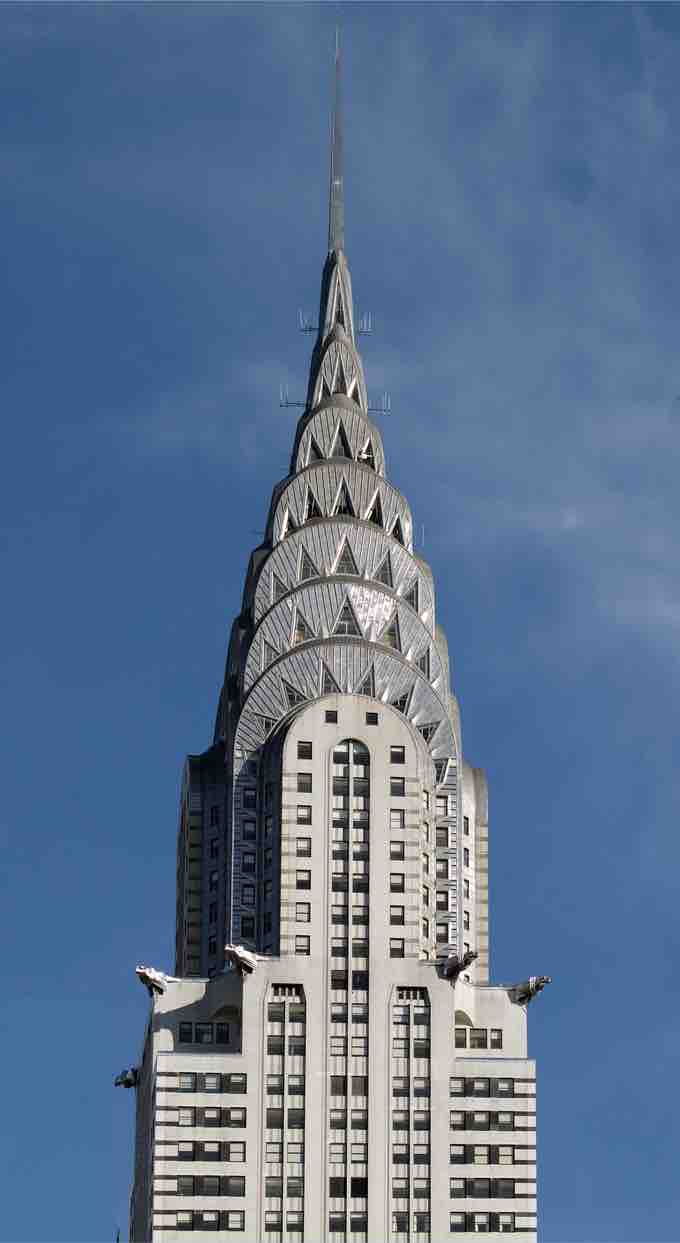Modern American architecture is usually divided into the two styles of Art Deco and Streamline Moderne. Art Deco, which emerged in the 1920s and flourished in the 1930s - 1940s, is an eclectic style that combines traditional craft motifs with Machine Age imagery and materials. Streamline Moderne, also known as Art Moderne, was a late type of the Art Deco design style that emerged during the 1930s. Its architectural style emphasized curving forms, long horizontal lines, and sometimes nautical elements.
The Art Deco style is often characterized by its use of rich colors, symmetry, bold geometric shapes, simple composition, rectilinear rather than curvilinear shapes, and lavish ornamentation. Emerging during the Interwar period when rapid industrialization was transforming culture, one of the major attributes of Art Deco was its embrace of technology. During its heyday, Art Deco represented luxury, glamour, exuberance, and faith in social and technological progress. The urban United States has many examples of Art Deco architecture, especially in New York, Chicago, and Detroit. The famous skyscrapers in these cities are the best-known, but notable Art Deco buildings can be found in various neighborhoods.
Eastern Columbia Building entrance, Los Angeles, 1930
The sunburst design executed in terracotta exemplifies Art Deco's characteristic combination of craft, ornament and geometrical motif.

Spire of the Chrysler Building, New York
The opulent Art Deco spire of the Chrysler Building in New York City, designed by William Van Alen, was built 1928–1930 and reflects the earlier lavish ornamentation, yet simple and streamlined composition of the style.
As the Great Depression decade of the 1930s progressed, Americans saw a new decorative element of the Art Deco style emerge in the marketplace: streamlining. Streamline Moderne was a concept first created by industrial designers, who stripped Art Deco design of its ornament in favor of the aerodynamic pure-line concept of motion and speed developed from scientific thinking. This aesthetic was embodied through the use of cylindrical forms and long horizontal windowing. An array of designers quickly ultra-modernized and streamlined the designs of everyday objects, such as toasters. Streamline Moderne was both a reaction to Art Deco and a reflection of austere economic times. Gone was unnecessary ornament. Sharp angles were replaced with simple, aerodynamic curves. Exotic woods and stone were replaced with cement and glass. Common characteristics of Streamline Moderne included horizontal orientation, rounded edges, corner windows, glass blocks, porthole windows, chrome hardware, smooth exterior wall surfaces (usually stucco), horizontal wall grooves, and subdued colors.

Hecht Company Warehouse
The Hecht Company Warehouse (Washington, D.C.) is a Streamline Moderne style building.The building uses glass block extensively, culminating in a twelve-pointed star-shaped cupola at the corner, which is illuminated at night. Black brick interspersed with glass block spells out "The Hecht Co" at the fifth floor.

Hollywood Palladium
The Hollywood Palladium (in Hollywood, CA) was a dance hall built in the 1940s in the Streamline Moderne style. This picture depicts the Palladium in 2005, prior to the 2008 renovation.
However, Art Deco and Streamline Moderne were not necessarily opposites. Streamline Moderne buildings with a few Deco elements were not uncommon, and sometimes there is so much crossover that it can be difficult to differentiate between the two styles.